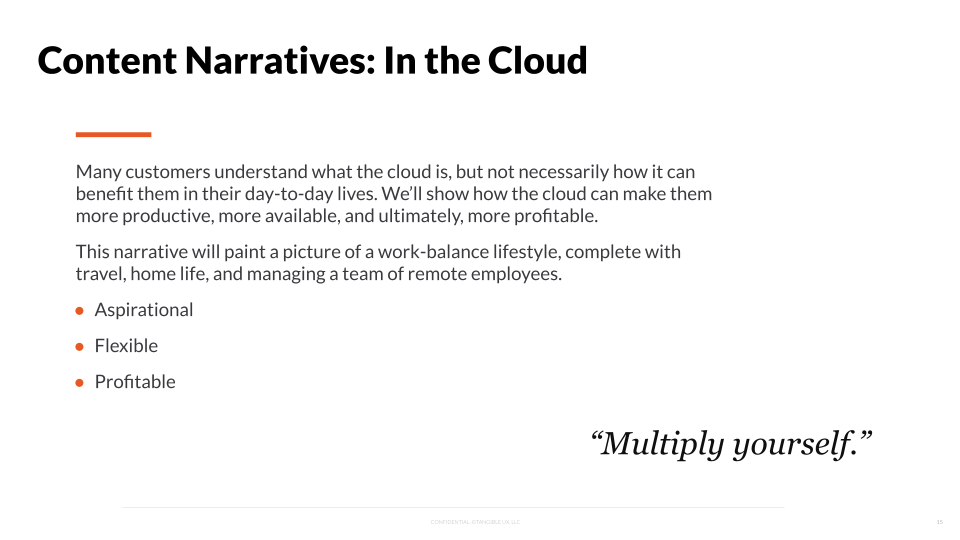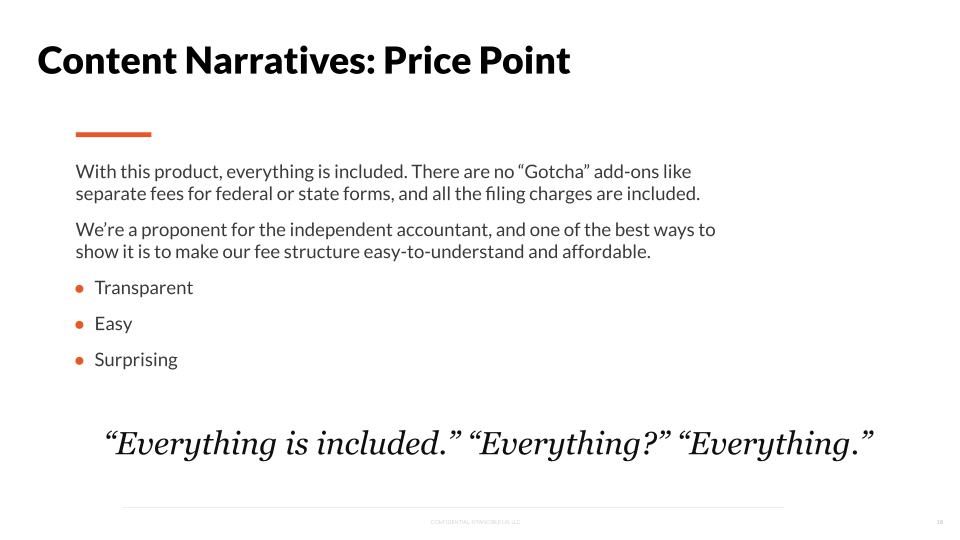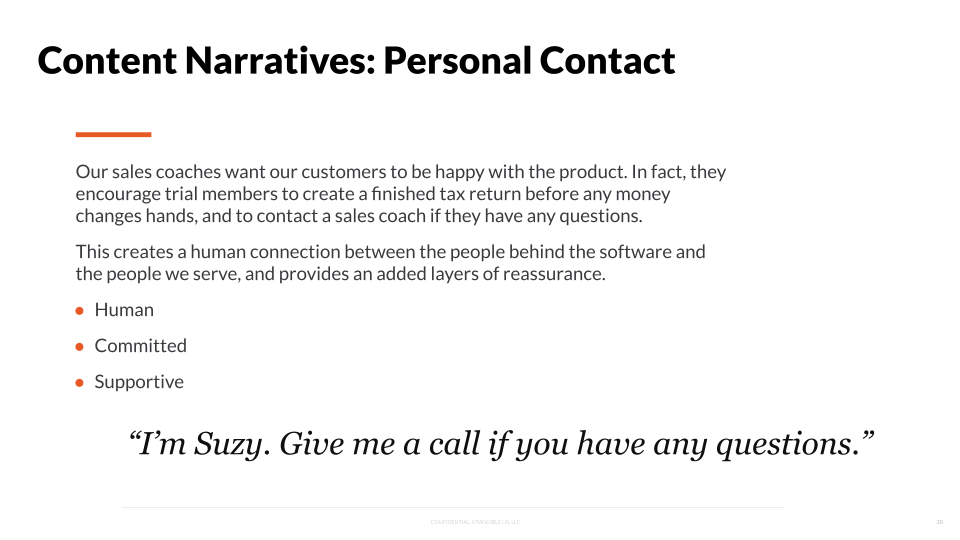So you’re crafting a product marketing campaign. You know your product’s functionality inside and out, and you have the roadmap memorized like the back of your hand. But ultimately, it doesn’t matter what you’re selling — you’re going to need to rely on one or more of the three modes of persuasion: logos, ethos, and pathos. (If you’re saying, “that’s Greek to me,” well, you’re right: these terms were coined by Aristotle.)
Logos speaks to the rational. These are your logical reasons to buy: the facts about your product or service. It’s the rational appeal of how many features it has, or how much money or time it can save you. Ethos refers to social proof and character. This is what others say about your offering, and how credible you are, through your ratings, reviews, and testimonials. Pathos consists of emotional appeal, imagination, and narrative. A content designer I used to work with often calls this “the things your customers dream about after they have visited your site or been touched by your campaign.” It’s the story of your product or service and its appeal to your customers’ aspirations. It’s what Simon Sinek means when he tells us to “start with why.”
Appeal to your audience’s imagination
Tangible has run hundreds of A/B tests for Fortune 500 clients over the last 15 years. Over and over again, we’ve found that the test based on the power of story wins. We’ve seen revenue increases in the tens of millions of dollars, and conversion metrics go up by 200%, simply by testing the power of story against the power of rational reasons to buy.
So how do we get a potential customer to dream about the way the product or service could change their lives? First, you need to capture their imagination. It’s less difficult than you might think: if Tangible can get accountants to dream of becoming the CPA equivalent of a rock star, you can get your audience to dream, too. You just need to find the right story.
The story is everything
Build magazine ran an article about the power of story, in which they showed that stories have the power to increase the perceived value of your product. Build sited an experiment on eBay wherein they were selling cheap, throw-away products. The products that had stories built around them, in a distinctive voice and style, sold for up to 2,706% higher than the normal and equivalent “non-remarkable” products. The “back story” crafted by a talented writer made all the difference.
Focus on the theme
Think about the concept of story/narrative like you might think of a movie theme. It’s the unifying or dominant idea of the movie. Such a theme is best if it’s brief and focused. A bad movie wanders all over the place (you know the type, where not only do you want your money back, but the last two hours of your life as well). Good movies (and good narratives about products and services) stay focused.
In his book, Story, Robert McKee explains, “The theme shapes the writer’s strategic choices … [guiding] your aesthetic choices toward what is expressive of your theme and may be kept — versus what is irrelevant to it and must be cut.”
The theme sets the stage for you to introduce the characters; set up the problem; work through the problem; and (finally) get to resolution. Just as it works for every good movie and story, it will work for your offering.
Every great story has a conflict — this one is about getting your stakeholders to believe in the power of story
When I said that capturing your audience’s imagination is easier than it sounds, I might have left you with the impression that running a product marketing campaign based on the power of your offering’s story will be a walk in the park. More often than not, where you run into problems is in getting your stakeholders to sign off. Often, clients are so handcuffed to their overly tested marketing messages or rational reasons to buy that they have a hard time accepting change. However, when we’re brought in is when they’re trying to get conversion — and the last creative that used these prescribed messages isn’t working. This hesitation can come all the way down from top management. We succeed by telling them that if they want different results, they are going to have to move beyond their comfort zone.
Once they are ready for change, we start by getting our stakeholders to tell their stories to us.
So, how do we uncover successful narratives?
The best people to tell you which stories you should be telling are your stakeholders and clients. They know the product. They’ve been sitting in on support calls. They’ve sat in LOTS of focus groups.
But getting these stories out of them can be tricky. As a culture, we’ve allowed our storytelling chops to atrophy. We let authors and filmmakers tell the stories. Once upon a time, our ancestors sat around and told stories about why and how we should hunt the woolly mammoth. They didn’t submit those stories to a publisher, or look for an executive producer. They knew that it was important to tell stories, and they were not forgotten. No user manuals or tech support calls were necessary.
I’ll give you some insight as to how we do it at Tangible. We know that deep down, everyone still knows how to tell stories. So we hold a brainstorming session designed to extract those stories. We ask our participants to talk about what they know:
- Main customer goals for the product. Why would they use it?
- The key features of the product or service. Just start listing them and talking about them in a free-form way.
- The feelings they want to instill in the customer. How do they feel before (and after) they use the product?
- The primary differentiators of the product. What does this product do that the competition doesn’t?
I like to be up in front of a white board with sticky notes, or a Mural, capturing every answer, and then putting them in each of the four categories above. We also have someone just taking notes of what the team is saying. If you listen carefully, you will hear the stories that are being told. They start to come out and flow out naturally, even when they’re talking about dry product features. A writer I work with on this methodology is a master at finding key phrases that the client or a stakeholder says, and spinning it right back to them as gold.
Another great way to get stories is to chat with the technical support folks. Usually they’re very nice and have tons of stories to tell you. (A note of caution: sometimes their managers can get upset at you for taking up their time, so be sure to get their buy-in before you set up these chats.)
By the end of the brainstorm, you should have a whiteboard full of sticky notes — and a long list of stories.
Dream a little dream
Next, you need to sleep on what you just heard. The next day, the best stories will float to the top like cream. As a smaller creative team (sans stakeholders), you should start to organize these stories. What did you hear?
- The story about how the great customer support makes the difference in the product
- The story about how this product changed the way people have done business for the better
- The story about how good the product made people look and how much it boosted their confidence.
Now for the pitch
The next step is crucial. You’ve gotten your stakeholders to buy off on theme and narrative as strategies worth pursuing. You’ve gotten them to understand that cramming more feature copy into the campaign will just make your narrative lose focus (and be correspondingly less effective). Now you need to organize these stories into concepts to pitch. This is your elevator pitch — while you may not be able to keep it to 25 words, that’s a good place to start. This will take a bit of crafting. But in the end you should have just that: a narrative pitch. (I don’t like to show pictures at this point. Go ahead and show them just the words.)
Below are some examples of different narrative pitches.


Once we’ve heard feedback (and gotten sign-off) on the narratives, we then move to the wireframing stage, in which we craft the narratives in a much more visual way.
(One quick tip: before we do the pitches, we make sure that our client fully knows we’re not ignoring those very important reasons to buy, feature bullets and marketing messages. We show them on a separate slide, so they know we won’t ignore them but don’t feel like they have to cram them into the narrative pitches.)
Let the story begin
In the world of product marketing, telling stories feels risky, so it’s tempting to cling to hard and fast facts. That’s why we need to bring our stakeholders along on the journey of telling a story. The stories are theirs: we’re brought in to bring out the stories and make sense of them, then give the client the courage to test them with their customers.
Reviews of each wireframe begin with a review of the associated narrative pitch. This way, we’re all on the same page regarding what we’re trying to convey in the product marketing campaign. If we’ve done our job, the tests will each focus on a narrative that’s meaningful to the client’s target. And the next story the client will tell is about how their “narrative” test recipe crushed the one they’d been clinging to for years.


